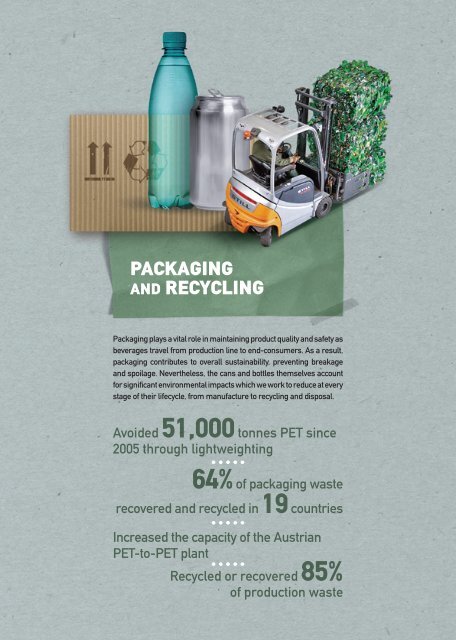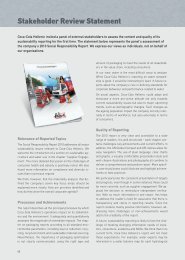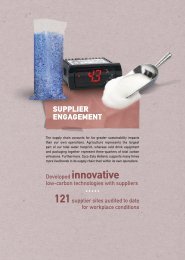packaging and recycling - Coca-Cola Hellenic Social Responsibility ...
packaging and recycling - Coca-Cola Hellenic Social Responsibility ...
packaging and recycling - Coca-Cola Hellenic Social Responsibility ...
Create successful ePaper yourself
Turn your PDF publications into a flip-book with our unique Google optimized e-Paper software.
PACKAGING<br />
AND RECYCLING<br />
Packaging plays a vital role in maintaining product quality <strong>and</strong> safety as<br />
beverages travel from production line to end-consumers. As a result,<br />
<strong>packaging</strong> contributes to overall sustainability, preventing breakage<br />
<strong>and</strong> spoilage. Nevertheless, the cans <strong>and</strong> bottles themselves account<br />
for significant environmental impacts which we work to reduce at every<br />
stage of their lifecycle, from manufacture to <strong>recycling</strong> <strong>and</strong> disposal.<br />
51,000 Avoided tonnes PET since<br />
2005 through lightweighting<br />
• • • • •<br />
64% of <strong>packaging</strong> waste<br />
recovered <strong>and</strong> recycled in 19 countries<br />
• • • • •<br />
Increased the capacity of the Austrian<br />
PET-to-PET plant<br />
• • • • •<br />
85%<br />
Recycled or recovered<br />
of production waste
Our Approach<br />
We reduce the environmental footprint of our <strong>packaging</strong> by:<br />
• Reducing materials <strong>and</strong> energy used in the manufacture of<br />
<strong>packaging</strong><br />
• Using recycled or renewable content to replace non-renewable<br />
material<br />
• Championing the recovery <strong>and</strong> <strong>recycling</strong> of packages: working<br />
with others to strengthen the infrastructure <strong>and</strong> consumer<br />
participation<br />
In addition to reducing use of non-renewable materials, these<br />
strategies help to drive down the carbon footprint of our packages.<br />
Our ultimate goal is to close the <strong>recycling</strong> loop, converting<br />
used packages into new. We have committed to invest in bottleto-bottle<br />
<strong>recycling</strong> plants wherever environmentally <strong>and</strong> economically<br />
sustainable. We have done so in Austria, where we co-own<br />
a plant which recycles up to 570 million PET bottles each year.<br />
Reducing Packaging<br />
Source reduction is the most significant way to diminish the<br />
impact of <strong>packaging</strong>. By reducing the material content of our<br />
packages, we reduce carbon emissions in manufacturing, as<br />
well as subsequent transportation <strong>and</strong> <strong>recycling</strong>.<br />
Our goal is that by 2012 we will reduce <strong>packaging</strong> used per litre<br />
of beverage by 25% compared to 2004. In 2010, this <strong>packaging</strong><br />
ratio was 7% higher than in 2004 <strong>and</strong> we used 771,000 tonnes of<br />
material, up 6.5% from last year. Much of this increase was due<br />
to the replacement of wooden pallets used to transport cases<br />
of beverage.<br />
For more than a decade, we have focused on lightweighting<br />
<strong>and</strong> all key packages now use considerably less material.<br />
• Lighter PET bottles: During 2010, we established new benchmarks<br />
for PET bottles. Our 500ml bottles for waters now<br />
Lightweighting of Packages<br />
2005<br />
2010<br />
PET 500ml<br />
(sparkling)<br />
Weight<br />
28 g.<br />
Weight<br />
20.7 g.<br />
Packaging Material Use Ratio<br />
(g per lpb)<br />
We have significantly reduced the material used to produce each of our main packages.<br />
1. Lowest achieved: 12.2 grammes.<br />
Glass 330ml PET 500ml<br />
Weight<br />
263 g.<br />
(still)<br />
Weight<br />
210 g.<br />
61 62<br />
69 68<br />
62<br />
+7%<br />
vs 2004<br />
65<br />
The amount of <strong>packaging</strong> material used to manufacture our products, per litre of<br />
produced beverage, has remained broadly stable. In 2010 it was 7% above 2004.<br />
weigh on average 18 grammes, 36% less than in 2005; while<br />
our 500ml bottles for carbonated beverages are 26% lighter<br />
(see below). As a result of these efforts, we avoided the use of<br />
more than 4,500 tonnes of PET in 2010. Since 2004 our lightweighting<br />
efforts have resulted in PET bottles that are now on<br />
average 16% lighter.<br />
• Short-height plastic closures: We continue to roll out shorter<br />
bottle closures across our business. Not only do these closures<br />
use less material, but they also allow bottle necks to<br />
be shorter <strong>and</strong> lighter, further reducing material use. By using<br />
these closures, we avoided 527 tonnes of material in 2010.<br />
• Light-weight glass bottles: In 2010 we introduced 55 million<br />
light-weight glass bottles using up to one third less material.<br />
• Cans <strong>and</strong> cartons: Although these represent only 16% of our<br />
primary <strong>packaging</strong> mix, we continue to work with suppliers<br />
on sustainability projects that include lightweighting.<br />
• Secondary <strong>packaging</strong>: We minimise our use of cardboard,<br />
shrink film <strong>and</strong> other materials to deliver products to business<br />
customers. Such projects benefit customers, too, reducing<br />
their <strong>packaging</strong> waste <strong>and</strong> labour costs.<br />
Average weight<br />
28 g.<br />
Average weight<br />
18 g. 1<br />
31
Packaging <strong>and</strong> Recycling<br />
As we seek opportunities to remove material from our packages,<br />
we work within constraints. If a package is not strong<br />
enough to withst<strong>and</strong> transportation <strong>and</strong> storage, this will lead to<br />
product waste, which typically accounts for considerably higher<br />
CO 2 emissions than <strong>packaging</strong> alone. Consumer appeal is another<br />
important consideration since the look, feel <strong>and</strong> convenience<br />
of <strong>packaging</strong> plays a significant role in br<strong>and</strong> preference<br />
<strong>and</strong> purchasing decisions.<br />
Recycled <strong>and</strong> Renewable Content<br />
Using recycled or renewable content is another way we lessen<br />
the impact of our <strong>packaging</strong>. These materials replace non-renewable<br />
materials, <strong>and</strong> their production uses much less energy<br />
– 85% <strong>and</strong> 95% less for recycled PET <strong>and</strong> aluminium respectively.<br />
While we focus on increasing the recycled content of our<br />
packages, The <strong>Coca</strong>-<strong>Cola</strong> Company has developed <strong>packaging</strong><br />
made with renewable raw materials, such as the PlantBottle.<br />
Recycled PET<br />
Aluminium cans <strong>and</strong> glass bottles contain up to 60% recycled<br />
content. By contrast, the maximum recycled content in our PET<br />
bottles was 30% in 2010. We increased the recycled PET we used<br />
in 2010 to approximately 6,500 tonnes. Nevertheless, this still<br />
represents a small proportion of total PET usage <strong>and</strong> we aim to<br />
increase this. The greatest obstacle is lack of a stable supply of<br />
recycled PET feedstock. Around half of PET bottles are recycled,<br />
of which approximately two-thirds 2 are diverted into the PET<br />
fibres <strong>and</strong> sheet industry which does not dem<strong>and</strong> food-grade<br />
quality st<strong>and</strong>ards. We must therefore enhance the efficiency of<br />
PET collection (see below) <strong>and</strong> increase our share of the recycled<br />
material produced. In 2010, we supported the introduction<br />
of another production line at the bottle-to-bottle <strong>recycling</strong> plant<br />
At the Pet-to-Pet Recycling plant in Muellendorf, Austria, a new processing<br />
line has been installed. The state-of-the-art <strong>recycling</strong> plant has been<br />
producing PET flakes from recycled PET bottles for many years <strong>and</strong> now<br />
using the latest technologies to turn used PET bottles into granulate.<br />
2. PETcore.org<br />
32<br />
we co-own in Austria. With access to more reprocessed PET, we<br />
aim to produce bottles with higher recycled content.<br />
PlantBottle<br />
In 2011, <strong>Coca</strong>-<strong>Cola</strong> <strong>Hellenic</strong> will launch PlantBottle, the<br />
award-winning PET bottle developed by The <strong>Coca</strong>-<strong>Cola</strong><br />
Company. Up to 30% of the PET in this package is derived<br />
from renewable plant-based waste material. The<br />
bottle has a lower carbon footprint than traditional PET<br />
yet maintains the same performance st<strong>and</strong>ards <strong>and</strong> is fully recyclable.<br />
<strong>Coca</strong>-<strong>Cola</strong> <strong>Hellenic</strong> will trial PlantBottle in Switzerl<strong>and</strong>.<br />
Promoting Recycling<br />
For our packages to be recycled or recovered, we work with industry<br />
<strong>and</strong> government to achieve two important pre-conditions.<br />
Firstly, we set up schemes to collect, recycle or recover <strong>packaging</strong>.<br />
Secondly, we encourage consumers to play their part in<br />
closing the <strong>recycling</strong> loop; otherwise empty cans <strong>and</strong> packages<br />
end up as l<strong>and</strong>fill or litter, not valuable feedstock for <strong>recycling</strong>.<br />
Recovery Organisations<br />
In 19 countries, <strong>Coca</strong>-<strong>Cola</strong> <strong>Hellenic</strong> has led the establishment of<br />
organisations to collect, recycle <strong>and</strong> recover <strong>packaging</strong>. In turn,<br />
these bodies work with 29,000 municipalities to provide 135 million<br />
people with access to collection systems. In 2010, 64% of<br />
our <strong>packaging</strong> was recycled or recovered in these countries.<br />
The challenge is to bring all territories up to speed, as there are<br />
still countries where collection <strong>and</strong> <strong>recycling</strong> are limited or nonexistent.<br />
We promote producer responsibility schemes since<br />
they facilitate both environmental <strong>and</strong> economic progress.<br />
During 2010, two new recovery organisations came into being.<br />
In the Former Yugoslav Republic of Macedonia (FYROM),<br />
Pakomak was officially approved, starting operations in 2011.<br />
In Serbia, Sekopak completed its first year of operations. Residential<br />
collection systems have been set up in 21 municipalities<br />
together with campaigns to teach residents how to separate<br />
waste. First-year results exceeded targets with almost<br />
nine tonnes of <strong>packaging</strong> recovered. Since some municipalities<br />
previously had no residential waste collection, this result is<br />
particularly encouraging.<br />
Other progress during 2010 included:<br />
• In Romania, we extended collection systems to include rural<br />
households. Again, this marked the first collection of waste<br />
of any kind. In 2010, 38,000 tonnes of PET were collected for<br />
<strong>recycling</strong>.
• In Russia, the new <strong>packaging</strong> <strong>and</strong> environment coalition Rus-<br />
PEC, chaired by <strong>Coca</strong>-<strong>Cola</strong> <strong>Hellenic</strong>, held its first multi-stakeholder<br />
conference. By bringing together government agencies,<br />
authorities, suppliers, manufacturers <strong>and</strong> recyclers, we<br />
developed comprehensive proposals for PET collection <strong>and</strong><br />
<strong>recycling</strong> for submission to the Russian Parliament.<br />
• In Hungary, we held a multi-stakeholder forum on PET <strong>packaging</strong><br />
waste. This led to new projects, including a lifecycle<br />
analysis with the Ministry of Environment, on-pack labelling<br />
of recycled content <strong>and</strong> other consumer messaging.<br />
Where recovery systems are in place, we remain actively involved<br />
<strong>and</strong> retain an ownership stake in 18 organisations. During<br />
2010, we began a new initiative to review <strong>and</strong> improve their<br />
performance. We paid almost €42 million in recovery fees in<br />
2010.<br />
We continue to work with government <strong>and</strong> industry to promote<br />
market mechanisms, technological <strong>and</strong> sorting innovations<br />
<strong>and</strong> creation of equitable closed loop <strong>packaging</strong> solutions.<br />
At an international level, we support efforts by industry<br />
associations to work towards a global st<strong>and</strong>ard of producer<br />
responsibility.<br />
Mobilising Consumers<br />
Since consumer participation is vital to the success of <strong>recycling</strong><br />
initiatives, we support education <strong>and</strong> awareness campaigns.<br />
We also mobilise communities to support clean-up operations<br />
<strong>and</strong> anti-littering campaigns.<br />
To stem the growing problem of plastic pollution in the Upper<br />
Tisza river basin, we support environmental projects in Romania<br />
<strong>and</strong> Ukraine. Lack of waste collection led residents to dump<br />
rubbish in rivers, floodplains or l<strong>and</strong>fills. In addition to pioneering<br />
rural collection, we conducted education <strong>and</strong> awareness<br />
campaigns <strong>and</strong> clean-up operations.<br />
Even where <strong>recycling</strong> infrastructure is established, consumers<br />
often lack access when away from home. We therefore include<br />
collection schemes at all events that we support, from sports<br />
Tackling plastic waste pollution in Ukraine<br />
L<strong>and</strong>filled Waste Ratio<br />
(g/lpb)<br />
5.0<br />
3.0 3.0 2.8<br />
Total L<strong>and</strong>filled Waste<br />
(million kg)<br />
Production<br />
volume<br />
4.5<br />
37.2<br />
29.7<br />
34.3<br />
33.7<br />
1.9<br />
21.6<br />
-71%<br />
vs 2004<br />
1.5<br />
-58%<br />
vs 2004 baseline<br />
17.6<br />
-5%<br />
vs 2010<br />
-90%<br />
vs baseline<br />
-80%<br />
vs 2004<br />
baseline<br />
tournaments <strong>and</strong> music festivals to product sampling. In 2010,<br />
we collected 141 tonnes of <strong>packaging</strong> at events.<br />
In-Plant Recycling<br />
Our goal is that all plants will recover or recycle at least 90%<br />
of production waste by 2015. We are on track to achieve this<br />
with 39 plants <strong>recycling</strong> 90% of waste <strong>and</strong> a further 14 plants<br />
achieving rates of 80%. As a result, we diverted 103,000<br />
tonnes of waste from l<strong>and</strong>fill, an absolute reduction of 58%<br />
since 2004.<br />
In the rural community of Drotyntsi, plastic waste had blocked a cross-section of the river <strong>and</strong> led to flooding. Our Green<br />
Danube partnership worked with local authorities to address the source of the problem by installing residential waste<br />
collection <strong>and</strong> setting up a collection centre where plastic waste is compressed <strong>and</strong> baled, ready for <strong>recycling</strong>. In addition<br />
to tackling a local environmental issue, the project has also created jobs in the collection system. A local awareness<br />
campaign is now underway. We also organised clean-up activities along the river.<br />
PAckAGING AND PAckAGING WAsTE POlIcy<br />
PET-TO-PET REcyclING PlANT<br />
The amount of waste from plants that is sent to l<strong>and</strong>fill, relative to the volume<br />
produced, is now 71% below 2004 levels. This results from reducing total<br />
waste <strong>and</strong> increasing <strong>recycling</strong> rates.<br />
Total waste from bottling plants that is sent to l<strong>and</strong>fill is now 58% below 2004.<br />
33




